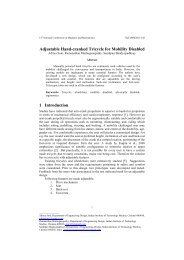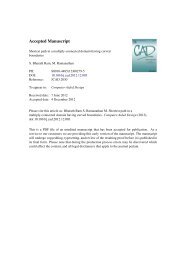Lecture 16
Lecture 16
Lecture 16
You also want an ePaper? Increase the reach of your titles
YUMPU automatically turns print PDFs into web optimized ePapers that Google loves.
• IIR has some properties similar to those of EPDM, such as good mineral acid and baseresistance (like EPDM some concentrated mineral acids are a problem), and weatherresistance which is similar to that of EPDM.• IIR has excellent resistance to permeability by gases. For example, Fusco [18]mentions its permeability to air being as low as 10% that of NR, at 65 deg C.• Like EPDM, the polarity of IIR is low which means poor resistance to petroleum oilsand conversely low swell in many polar solvents, such as ketones.• Resilience is poor, which translates to good damping ability.• The upper continuous heat aging temperature limit is around 121 deg C, which can bedistinctly improved with IIR compounds containing resin (polymethylol-phenol) curesystems.• For low temperature properties the vulcanizate becomes stiff and leathery at around -18 deg C, although it is not brittle until around -70 deg C.• Applications naturally following from these properties include mounts and bumpersfor vibration and shock prevention, roof and tank linings, curing bladders and innertubes for tires.• A significant use is inner liners for tubeless tires, where halobutyl is preferred due toimproved interply adhesion with the rest of the inner tire.Rubber Polymer type : Butyl Rubber2.3.6 Butyl rubber IIR and halobutyl rubber CllR and BllRButyl rubber is a copolymer of isobutylene and isoprene, hence IIR. If a halogen, such aschlorine or bromine, is introduced into the polymer architecture, it becomes CIIR or BIIR,respectively.




